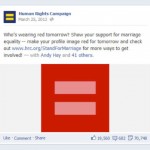 Facebook is undoubtedly a huge beast in terms of the sheer number of people that use the site. Alas, the credibility of efforts made on the site by charities and other social enterprises have given rise to the slacktavism tag. It defines the support offered to a cause by an individual that is rather easy to give, yet not particularly effective for the charity involved.
Facebook is undoubtedly a huge beast in terms of the sheer number of people that use the site. Alas, the credibility of efforts made on the site by charities and other social enterprises have given rise to the slacktavism tag. It defines the support offered to a cause by an individual that is rather easy to give, yet not particularly effective for the charity involved.
I’ve written a few times about research into this phenomenon, with studies suggesting, for instance, that the more public the display of support, the less likely that person will offer something of substance to the cause (ie time or money). The inference was that Facebook as a platform encourages these superficial shows of support, therefore undermining attempts to garner substantial support from the public.
A new paper published recently suggests that things might not be all bad. The focus of the study is the Human Rights Campaign’s (HRC) Marriage Equality project, whereby Facebook users were encouraged to display the red equals sign as their profile photo in support of the campaign.
The aim of HRC is to support equality for lesbian, gay, bisexual and transgender people. The equals symbol achieved 25,000 likes and 75,000 shares in the first 24 hours of its unveiling, with viral modifications of the logo quickly emerging. Did this activity lead to lasting support for the group however?
The paper explains how the initial (albeit short lived) popularity of the meme attracted the attention of both news outlets, and political figures. Despite this however, there was also a considerable level of ‘support’ for the campaign from people who may not have been totally aware of what they were supporting.
“That is, they may have simply seen the logo as an interesting image to place in their profile for a brief period of time, rather than intending specifically to pass on the message of the HRC” the paper says.
Nevertheless, it argues that even these seemingly trivial shows of support can add up. They constitute what the author defines as microaggressions, which are the small things we see frequently in our daily lives that help to contribute to our perspectives. In this context, continuous small slurs around sexuality can contribute significantly to ones wellbeing. It is here, the author suggests, that campaigns such as the HRC one can play a role.
“A lesbian who lives in an area where homophobic slurs, graffiti, jokes, or other forms of everyday violence are common might find solace in seeing her Facebook News Feed filled with images celebrating and supporting gay rights” it says.
It concludes by arguing that even these small, often flawed, signs of support are better than offering none at all, and that these small contributions form part of a larger and more complex network of interactions that all contribute to our perceptions and behaviours.
“The spread of memes like the HRC logo illustrates that memes are not simply minor moments of slacktivism, but are part of a complex web of digital activism that involves creating content, transmitting memes, and remixing messages that can have significant impacts on off–line behaviors”